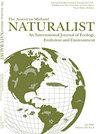Spawning and Embryonic Development of the Least Brook Lamprey (Lampetra aepyptera)
IF 0.6
4区 环境科学与生态学
Q4 Agricultural and Biological Sciences
引用次数: 0
Abstract
Abstract. The reproductive biology of lampreys is of special interest given the group has retained many developmental features reminiscent of the earliest vertebrates. Herein I report spawning behavior in the Least Brook Lamprey (Lampetra aepyptera) from southern Indiana and provide descriptions of its embryonic development. Nesting activities began in mid-March when water temperatures ranged from 10 to 12 C, as two or more individuals dug out shallow depressions in loose gravel immediately above riffles. Communal spawning groups (>10 individuals) subsequently formed at the nest sites when the water temperature rose above 12 C. Embryos generated from the gametes of spawning adults underwent gastrulation 72 h after fertilization, neurulation after 6 d, and hatched after 14 d. Prolarvae developed melanophores 19 d after fertilization, eyespots were visible by 20 d, and the velum began to beat 25 d after fertilization. Expulsion of yolk from the intestine and filter feeding occurred 26 d after fertilization. Embryonic development in L. aepyptera largely matches the embryonic stages established for the Sea Lamprey (Petromyzon marinus), with subtle differences in the sequence of specific developmental features. These descriptions clarify conflicting accounts of spawning activities for L. aepyptera and provide staging criteria for future investigations into its embryonic development.最小溪斑蝶的产卵和胚胎发育
摘要七叶树的生殖生物学特别令人感兴趣,因为该类群保留了许多让人想起最早脊椎动物的发育特征。在此,我报道了来自印第安纳州南部的Least Brook Lamprey的产卵行为,并对其胚胎发育进行了描述。筑巢活动始于3月中旬,当时水温在10至12摄氏度之间,两个或两个以上的个体在浅滩上方的松散砾石中挖出浅洼地。当水温升高到12C以上时,随后在巢位形成了共同的产卵群(>10个个体)。产卵成虫配子产生的胚胎在受精后72小时经历原肠胚形成,6天后经历新胚形成,14天后孵化。受精后19天Prolarvae发育出黑色素细胞,20天后可见眼点,受精后25d绒毛开始搏动。受精后26天,卵黄从肠中排出并进行滤食性喂养。aepyptera的胚胎发育在很大程度上与海鳗(Petromyzon marinus)的胚胎阶段相匹配,但在特定发育特征的序列上存在细微差异。这些描述澄清了对灰蝶产卵活动的相互矛盾的描述,并为未来对其胚胎发育的研究提供了分期标准。
本文章由计算机程序翻译,如有差异,请以英文原文为准。
求助全文
约1分钟内获得全文
求助全文
来源期刊

American Midland Naturalist
环境科学-生态学
CiteScore
1.20
自引率
0.00%
发文量
38
审稿时长
18-36 weeks
期刊介绍:
The American Midland Naturalist has been published for 90 years by the University of Notre Dame. The connotations of Midland and Naturalist have broadened and its geographic coverage now includes North America with occasional articles from other continents. The old image of naturalist has changed and the journal publishes what Charles Elton aptly termed "scientific natural history" including field and experimental biology. Its significance and breadth of coverage are evident in that the American Midland Naturalist is among the most frequently cited journals in publications on ecology, mammalogy, herpetology, ornithology, ichthyology, parasitology, aquatic and invertebrate biology and other biological disciplines.
 求助内容:
求助内容: 应助结果提醒方式:
应助结果提醒方式:


